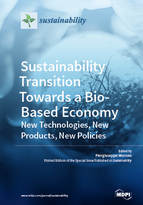Sustainability Transition Towards a Bio-Based Economy: New Technologies, New Products, New Policies
A special issue of Sustainability (ISSN 2071-1050).
Deadline for manuscript submissions: closed (16 April 2018) | Viewed by 112549
Special Issue Editor
Interests: environmental economics; food waste; trade economics; sustainability transitions; knowledge economics; economics of innovation; evolutionary economics; development economics
Special Issue Information
Dear Colleagues,
Significant changes are expected to occur in the near future. Most notably, the world’s population which stands at 7.5 billion in mid-2017 is projected to increase by almost one billion people within the next decade, and to reach 9.6 billion by 2050. At the same time, large and fast-growing economies will experience increasing wealth. The composition of the global population will therefore change significantly (Morone, 2016). Over the next 15 years, the number of people considered to be part of the global middle class is projected to nearly double, increasing from 3.2 billion in 2016 to more than 5.2 billion by 2030 and the bulk of this growth will come from developing countries—with the vast majority (88 percent) of the next billion people in the middle class being Asian (Kharas, 2017)
A major effect of these trends is higher consumption and demand for food, consumer durables, and energy sources, as well as services including tourism, entertainment, and transport. All this adds pressure to the incumbent socio-technological regime (fossil-based) and calls for a transition towards a more sustainable one (bio-based).
Among others, key drivers of this transition are:
- development and diffusion of new green technologies (eco-innovations) for a bio-based economy;
- development of a holistic approach for sustainability assessment of bio-based products (e.g., sustainability schemes, standards and eco-labelling initiatives)
- policy measures for promoting market uptake of bio-based products and creating a level playing field among different bio-based products and fossil-based alternatives;
The objective of this Special Issue is to bring together cutting-edge studies on the role of these three drivers in making the transition toward a sustainable economy. Specifically, this Special Issue invites theoretical and empirical studies addressing one or more of these drivers, although other relevant and related topics will also be considered.
Prof. Piergiuseppe Morone
Guest Editor
Manuscript Submission Information
Manuscripts should be submitted online at www.mdpi.com by registering and logging in to this website. Once you are registered, click here to go to the submission form. Manuscripts can be submitted until the deadline. All submissions that pass pre-check are peer-reviewed. Accepted papers will be published continuously in the journal (as soon as accepted) and will be listed together on the special issue website. Research articles, review articles as well as short communications are invited. For planned papers, a title and short abstract (about 100 words) can be sent to the Editorial Office for announcement on this website.
Submitted manuscripts should not have been published previously, nor be under consideration for publication elsewhere (except conference proceedings papers). All manuscripts are thoroughly refereed through a single-blind peer-review process. A guide for authors and other relevant information for submission of manuscripts is available on the Instructions for Authors page. Sustainability is an international peer-reviewed open access semimonthly journal published by MDPI.
Please visit the Instructions for Authors page before submitting a manuscript. The Article Processing Charge (APC) for publication in this open access journal is 2400 CHF (Swiss Francs). Submitted papers should be well formatted and use good English. Authors may use MDPI's English editing service prior to publication or during author revisions.
Keywords
-
Sustainability transition
-
green technologies
-
bio-based products
-
sustainability assessment
-
policy measures
-
sustainability scheme, standards, (eco)labels and certifications.






